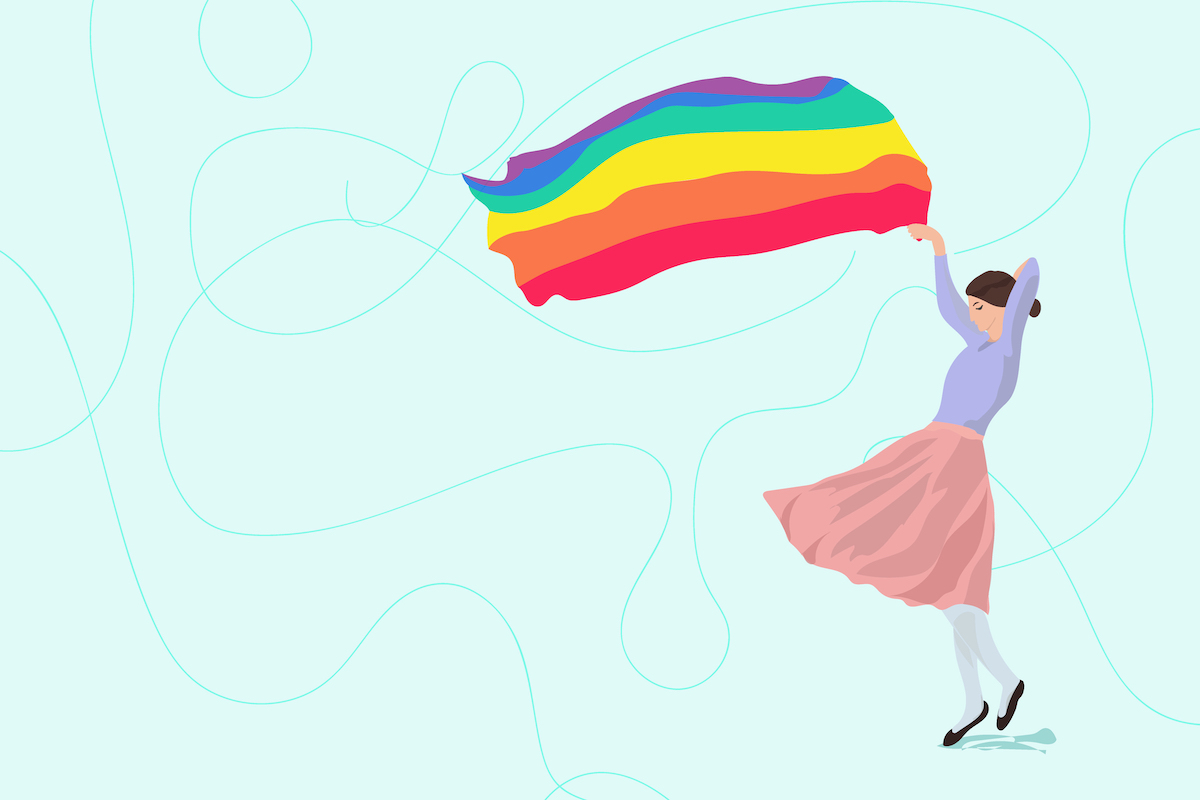When I was invited to speak at Jew York Pride this past June to discuss my queer advocacy at Yeshiva University, I was beset with imposter syndrome. As a former Hasidic Jew with a complicated relationship with Judaism and queerness, I feared I was out of my element. However, my imposter syndrome melted away as diverse Jewish LGBTQ+ powerhouses, including Adam Eli, Rachael Fried, Levi Maxwell, and Mordechai Levovitz shared their truths.
While I am comforted by my Jewish queer family, I cannot overlook the plight of Hasidic queer Jews, who all too often get disregarded in advocacy discourse.
I mentally detached myself from my Hasidic identity when I was in the seventh grade. I disowned my Hasidic traditions when my family reprimanded 12-year-old Molly for announcing her plans to attend college. My yearning for an educated and liberated life frightened my parents and older siblings, as those plans would prevent me from finding a suitable shidduch [match] when I graduated from high school. Their rebukes only motivated me to make good on my college plans. In August 2016, I physically left the Hasidic community to begin my first semester at Yeshiva University.
“You’ll come back to us,” my mother swore as she dropped me off at the Yeshiva University dormitories on my first day. “You’ll hate it here.” I knew she said this out of sorrow and I forgave her. Her youngest child was rejecting her world and she couldn’t prevent it. As time passed and my family recognized that I would not be returning to the Hasidic fold, they accepted my decision, welcoming me home whenever I wished to visit. Their unconditional love, however, buckled under the weight of my queer identity.
In August 2018, I came out to my family as bisexual. I expected little support. I expected to see pangs of disappointment wash over my parents’ faces. I expected weaponization of my mental illness to undermine my queer identity. I expected mention of conversion therapy.
Indeed, these expectations were met within hours of coming out. What I did not expect was a Hasidic family member sharing their queer identity with me soon after. I was uplifted until I realized that their coming out was a means of persuading me to come back in. “I might be attracted to men, but that doesn’t make me bisexual,” they said as I listened, exhausted by the shock. “See, that means you aren’t bisexual either.”
I was distraught to know other members of my family were forced to make the same choice I was facing: tradition or self. My distress was exacerbated by the rigid binaries which occupied my thoughts. Everything was black and white in my Hasidic mind: you were Hasidic or non-Jewish; virgin or whore; moral or LGBTQ+. I grappled with all these adjectives and identities myself, yearning to find my place in a world of grays when I was bred to live my Judaism, queerness, and womanhood in the extremes. Maybe they’re right, I thought after coming out. Maybe I’m not bisexual. Maybe this is the result of my mental illness or meshugas [craziness]. Maybe I need to become Hasidic again to wipe myself clean of my bisexuality.
I overcame doubts about my identity by befriending dozens of queer, closeted students at Yeshiva University. The unyielding love, pride, and dedication the Yeshiva University queer community showed themselves and each other shredded my uncertainties. They helped me develop the confidence to be safe in my own skin — and eventually help others feel safe in theirs.
Although I am now a proud genderqueer bisexual woman with a record of leadership in the Jewish queer world, I cannot help but feel like I’ve neglected the Hasidic queer community. To find an identity that went beyond “ex-Hasidic,” I needed some time to find my sea legs in a non-Hasidic world. Now that I’ve done so, I am ready to advocate for those I’ve left behind.
In my experience, many non-Hasidic Jewish communities treat Hasidism like a living museum. They view Hasidic communities as mausoleums to shtetl life, not quite real and not quite worth the effort. Non-Hasidic Jews will hardly ever dedicate their time, effort, or funds to assisting Hasidic youth because they don’t see that demographic as worth the concern. I’ve heard people in my non-Hasidic Jewish communities say, “Hasids are not worth the effort;” “They don’t want our help;” and, “Let’s focus on communities that will listen.” While they discount the need to assist the Hasidic community, thousands of Hasidic youth are forced to conform to a traditional, patriarchal, heterosexual, binary standard that they cannot escape from.
Many Jewish organizations do admirable work to promote extensive reforms for LGBTQ+ youth. Organizations like Eshel, Jewish Queer Youth, and Keshet are on the front lines of advocating for queer children and young adults strewn in closets around the country. However, these organizations do not do enough. Not because the organizations are run by individuals who do not care, but because the general consensus in the Jewish community is that Hasidic people aren’t worth the trouble.
For many Jewish communities, Hasidic fables and philosophies are potent when shared from the pulpit or in the classroom, but Hasidic people themselves are treated like fables. Jewish leaders of non-Hasidic institutions want to leave good enough alone – tikkun olam, they shout, but not for their own kin.
An organization which does its best to help those looking to emerge from the Hasidic community is Footsteps, which “supports and affirms individuals and families who have left, or are contemplating leaving, insular ultra-Orthodox Jewish communities in their quest to lead self-determined lives.” While their work is transformative, Footsteps cannot assist many Hasidic queer youth due to laws regulating the assistance of minors in the United States. Additionally, the Hasidic community has vilified Footsteps, leaving Hasidic youth terrified of fraternizing with the organization.
All Orthodox communities require LGBTQ+ advocacy, and we have a long way to go before queer youth of faith feel safe in society. Orthodox advocacy is mounting, with events like Jew York Pride and Eshel’s FunOrthodox that carve out spaces in the Jewish community for Orthodox youth. Yet in all these conversations, activism for Hasidic queer youth is critically deficient. Unlike other Orthodox youth, most Hasidic youth are mostly prohibited from using the internet, reading secular books, watching television, and interacting with non-Hasidic communities. This insularity generates a vacuum in which queer identities have no opportunity to breathe.
Many Hasidic individuals, especially women, do not learn about sex until they are already engaged to be married. If Hasidic youth have no concept of sex, how can they have concepts of their sexualities? And even if they do, how can they express that? Some express it through panicked sexual rendezvous in camp forests or in yeshiva bedrooms; others form homoromantic relationships as teenagers, but most never actualize their romantic and sexual desires.
The same concept applies to gender identity. With no option aside from a binary, Hasidic youth have no words for the complex, layered gender identities that define them. Abby Stein, a transgender woman who grew up Hasidic, has commented on the absence of language to describe gender identities in the Hasidic community. “I didn’t even know the term transgender until I was 20. I didn’t know there were other people who felt like me out there. They weren’t even homophobic. It’s ironic,” she said to Alma. “I sometimes wish that my teachers or parents growing up were homophobic or transphobic openly because it would have meant that I knew about it.”
My plea to the Jewish queer community is a personal one. I was once a concealed Hasidic girl with no resources, no community, and no language to define myself. I once wished that other Jews would recognize my pain – recognize my longing for a better life – and provide help. No queer child should suffer, living in a cage within a box within a closet. No queer child should be forced to choose between their Judaism and their queerness. That is the choice that Hasidic children have to make if they are lucky enough to discover their identities before they are married at 18 years old, with a child a year later. Without external resources, opportunities for Hasidic queer youth are close to none. This is a public health crisis, and the Jewish community must grapple with it immediately.
My queer journey would not have involved doubt, loneliness, and trauma if the non-Hasidic Jewish community fought for me. If there were pamphlets in my local library, an activist push for mandatory sex and gender education in private schools, or visible mental health resources for Hasidic teenagers, I would have recognized my worth as a Jewish queer person. I would not have seen myself as abominable. While I consider myself strong, with an activist bent that was molded by my trauma, I’d have chosen a happy childhood over an isolated one.
So, how can you help? Read books about the Hasidic experience. Donate to Hasidic children through Jewish Queer Youth, the only organization of its kind currently dedicated to assisting the Hasidic queer community. Help fund Hasidic education organizations advocating for less insularity. Just don’t give up — we are very much worth the effort.



